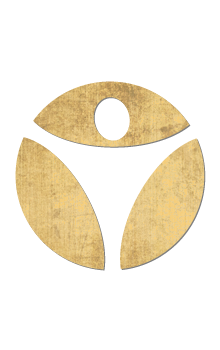How to Clean a Yoga Mat
- Updated on: February 11, 2024

Is Your Yoga Mat Clean?
Do you know how to clean a yoga mat? Did you know that some yoga mats contain eight times more bacteria than a toilet seat?
Let that sink in for a second.
Gym equipment in general is likely to be covered in bacteria. This bacteria can make you sick and cause all kinds of health problems. Think about the world we currently live in and the germs and viruses that we now have to fear. Gym equipment holds onto these germs, and a lot of this equipment is not cleaned properly.
One study actually swabbed gym equipment to see just how many germs are hiding in things that we use everyday, and the results were horrifying. The mats that were swabbed were used in hot yoga, but they were still wiped down at the end of every class, and they still came back with these results. According to the study, fifty-two percent of the bacteria was gram-positive cocci. This type of bacteria can cause all kinds of infections. The measure of colony forming units showed up as more than twenty-five thousand. A toilet seat holds about thirty-two thousand colony forming units. (Filthy fitness)
Pretty gross, huh?
Dr. Greg E. Cohen, a podiatrist, was actually interviewed by the New York Times, and he came forward to say that he has seen a fifty percent spike of athlete’s foot and plantar fasciitis in two years. When asking patients if they do yoga or use exercise mats, the answer was often yes. The problem is that many gyms will clean their mats but they might not do so correctly. In addition, even if they are properly wiping down their mats, most materials have soaked up bacteria from sweat, dead skin, and much more. (Ellen, 2006)
If you are using a communal yoga mat, you are also interacting with germs that have come from other people. Imagine what types of bacteria you might come across that are not even from you! This is why communal mats can get so disgusting, and if they are not cleaned properly, the bacteria will just keep growing and expanding as new bacteria sets in. Some people even wind up with skin infections after using a communal yoga mat. Some mats that are not cleaned well are even said to have up to 100,000 bacteria per cubic meter. Certain bacteria can grow and duplicate in only thirty minutes. Other bacteria can continue to feed what is already on the mat. This creates a cycle of nasty germs living in communal mats that people continue to use over and over. (Ricci, 2012)
The biggest problem is that people do not often know how to correctly clean a yoga mat, resulting in a build up of germs. The common materials used to make yoga mats are usually a great place for growing and spreading bacteria since they are so porous.
The more a person sweats in a class, the more germs are left over on a mat. These germs can cause infections like plantar warts, staph infection, and so much more.
It should be obvious now just how important it is to keep a yoga mat clean. When your mat is clean, you are ensuring a healthier practice for yourself.
Many of the mats tested were simply communal mats at a gym. This is why it can be helpful to bring your own mat to class. However, even a mat from home can harbor bacteria. So, what can you do to avoid these germs and stay safe?
How Often Should You Clean a Yoga Mat?
Many yoga mats actually absorb sweat into their pores, so while you might be cleaning the top layer of your mat, you could be missing the majority of the germs beneath that layer. This also depends on what material you are using. Certain material are much more likely to absorb sweat and germs than others,
How often should you be cleaning your yoga mat? The truth is that the right amount of cleaning your mat will vary based on the material of your mat and how often you are actually using it. It is recommended to give your mat a quick wipe down after every practice, especially if you were sweating. It is very common to sweat during a yoga practice. Think about how many germs are left behind on your mat after each class. A quick wipe down will only do so much.
Doing a deep clean at least once a month can be helpful in killing germs.
But how should you be cleaning your mat? Is there a right way and a wrong way?
Are there different ways to disinfect your mat?
Are some ways more effective than others?
What should you do if your mat is starting to smell bad?

Cleaning for Germs vs Cleaning for Smell
Your yoga mat can begin to smell from bacteria building up within it. This can mean that the more it smells, the more germs it has. If your mat smells bad, this is probably a sign that it definitely needs to be disinfected sooner rather than later. As dead skin cells and sweat soak in and collect in a mat, bacteria continue to grow and can cause that weird smell that mats sometimes carry. The more you wait to clean your mat while continuing to practice with it, the more likely you are to be exposing yourself to all kinds of germs, bacteria, fungi, and so much more. Would you really want to be using a mat that could make you sick? Is it worth the foot fungus and other illnesses?
Luckily, there are options for cleaning your mat at home.
There are many different ways to clean a mat. Some mats can go in a washing machine (though most cannot). You can always check to see if your mat is able to go into the wash, but be very careful to ensure that you will not damage your mat by doing so.
For a quick clean of the top layer of your mat, you can mix warm water and a few drops of dish soap in a bowl and then use a towel to wipe the soapy water across the mat. Dish soap can be helpful in killing some germs for sure, but how much is it helping with the smell of your mat?
Again, when a mat smells, this is a sign of bacteria build up. Is there a way to properly kill the germs and get rid of the smell?
One of the best solutions for cleaning a mat can be made out of what you have at home. All you need is one part vinegar to three parts warm water. Mix this in a spray bottle and spray the solution onto your mat. When you are done, use warm water to wipe away the excess vinegar. Vinegar kills germs and gets rid of bad smells. If you do not have vinegar, feel free to use tea tree oil instead. These can also be mixed together for a more potent solution.
Also, do your research on what your yoga mat can handle. Some brands and materials do not respond well to vinegar. (https://teamtapper.com)
Keep in mind that most good yoga mats do come with directions for cleaning them. If you do not feel comfortable using homemade cleaners, there are so many yoga mat cleaners that you can buy online or in stores as well.
When it comes to mats that smell really bad, you can also use a few drops of essential oils, but we will come back to learn more about this process in a bit.
Different Types of Yoga Mat Cleaners
Always check the directions that come with your mat before cleaning. Sometimes, there are certain mats that cannot handle specific remedies. There are many yoga mat sprays that you can buy in the store or order online. Checking the reviews of cleaners can be helpful to ensure that the ones you are buying will work well and not harm your mat.
Many cleaners that you will buy include lavender and other essential oils to keep your mat smelling fresh and clean while also disinfecting. Some cleaners have more natural ingredients than others. Take your time to find the best cleaner for you based on how often you are using your mat and how much your mat needs to be cleaned. Look for cleaners that have mostly essential oils and other natural ingredients.
Some of the best yoga mat cleaners are ones that are organic are have essential oils in them. If you can avoid the cleaners with harsh chemicals, you are better off.
If you choose to use wipes for your yoga mat, there are some that come presoaked in mat solution. Some of these brands are even biodegradable.
You can also use alcohol or disinfecting wipes as well. These can be pretty strong and helpful in killing germs on the top layer of the mat. However, if you choose to use plain rubbing alcohol that is not in a wipe form, please dilute it with warm water first.
There are also many gym equipment cleaners out there that you can buy that double as mat cleaners. Just keep in mind that these often have stronger chemicals as well.
We recommend sticking to more natural solutions if you can. Why are essential oils such a great option for your mat? Keep reading to find out.
How to Make Yoga Mat Cleaners at Home
As you now know, vinegar and/ or tea tree oil can be great for disinfecting a yoga mat, but what other natural remedies can you use?
Let’s take a look at common mixtures you can make at home to clean your mat:
Dish soap- Mix a few drops of dish soap with warm water. It should be pretty obvious why this works, but make sure a yoga mat can have soap used on it. This is one of the easiest and quickest ways to clean your mat.
Tea tree oil- Mix one part tea tree oil to three parts water (feel free to add vinegar). Tea tree oil is a natural antibacterial and can help to break down the bacteria that can build up in your mat.
Vinegar- Mix one part vinegar to three parts water. Vinegar will kill germs and get rid of heavy smells. Wipe with warm water when you are done.
Witch hazel- Mix one part witch hazel to three parts water. Witch hazel has natural antiseptic properties which is why so many people use it for skin cleaning. You can use this solution to wipe down your mat.
Lemon and baking soda- Mix one teaspoon of baking soda with two teaspoons of lemon juice and then add warm water. Wipe your mat down with this solution. Lemon adds a nice scent and helps to disinfect while baking soda also kills germs.
How to Use Essential Oils to Clean a Yoga Mat

As you now know, you can use essential oils to clean a yoga mat. Let’s look more into why this works and how you can create your own essential oil mixtures at home to keep your mat clean and smelling fresh.
Tea tree oil is just one of the many to choose from, though it does hold more antibacterial properties. Tea tree oil is a good recommendation and place to start. If you are unsure of which oil would be best, we recommended trying this one out. However, many people will use lavender, eucalyptus, peppermint, patchouli, lemon grass, orange oil, and so much more.
One fascinating study actually looked into which essential oils were the most effective in killing bacteria. The oils tested were ageratum, peppermint, citronella, aegle, geranium, palmarosa, lemongrass, eucalyptus, orange, patchouli. They were tested against twenty-two bacteria to see which ones fought them off the best.
The only oils known to kill every strain they were tested against were orange oil, peppermint, lemon grass, and eucalyptus. In addition, the oils were tested against twelve fungi to check their antifungal properties. Most oils were actually effective against all twelve, but eucalyptus and peppermint only worked against eleven, and ageratum was only effective against four. (Pattnaik, et al.) With all of this in mind, it can be easy to see how essential oils can naturally clean and disinfect without all of the harsh chemicals with many cleaning products out there.
When making a yoga mat cleaner with essential oils, it can be good to mix them with witch hazel and warm water to ensure your mat is extra clean. Some of the best essential oils to use here would be peppermint, orange oil, lemon grass, lavender, and eucalyptus since they are the most effective in killing bacteria. Though lavender oil was not used in the study we looked at above, it has been known to have antibacterial and antifungal properties. Another popular antibacterial essential oil, that was not included in the study mentioned above, is cedarwood.
Now that you have learned more about essential oils, you can take your pick of the best oil for you. Pick your favorite scent from these oils and design your own customized yoga mat cleaner to ensure a healthy and good-smelling mat.
However, if you are using witch hazel and just want to add some oils to make your mat smell extra good, feel free to try out the oils that are your favorite scents. Just make sure that the oils you are using will not react badly with your yoga mat.
The Best Antimicrobial Yoga Mat Material
Did you know that certain yoga mats are better than others when it comes to preventing bacterial growth? The problem is that most yoga mats are very porous and absorb sweat and germs, causing more bacterial growth. The majority of materials will do this, but most people do not know much about the mats they are buying, leaving them exposed to many germs without realizing it.
There are a variety of yoga mat materials out there to choose from, and if you do not know the pros and cons of these materials, you will not have the preparation to pick the best possible mat for you. Some use charcoal in their mats to soak up sweat and help break down bacteria, but the more sweat is absorbed, the more bacteria can grow. Others use rubber, which may not absorb as much sweat, but still holds on to some bacteria. PVC (polyvinyl chloride) mats are very popular since the material is cheaper, but they definitely absorb sweat and bacteria and are not environmentally friendly. TPE (Thermoplastic elastomer) yoga mats are also less porous and do not gather as many germs, but you still need to clean the mat often to ensure there is no bacterial growth. NBR (nitrile-butadiene rubber) is often a closed-cell mat, meaning it might not hold as many germs. This also means it can be easier to clean, but there is one yoga mat material that is best for preventing bacterial growth. This material is cork.
Cork yoga mats are non-porous. Cork is naturally this way, and this is why it is used as a wine-bottle stopper. When used in a yoga mat, cork does not absorb sweat and germs like other mats do. Instead, the sweat will simply sit on the top layer of the mat, making it much easier to clean and disinfect. In addition, the more you sweat with cork, the sticker your mat will get, having more of a grip the more you use it. This can actually enhance your yoga practice while keeping you safe from germs. Isn’t that awesome?
Different cork materials will differ on how often to clean them. It depends on the specific cork mat you are using. Some cork mats only provide a top layer of cork that is about as thin as sandpaper. These mats will only be able to deflect so much when it comes to bacteria, fungi, and germs.
Due to the antimicrobial properties of a cork mat, it will not have to be cleaned as often. Though you should always give your mat a quick wipe down after class, the surface is where the sweat and germs will be sitting, so you can easily disinfect that top layer and be good to go. You will not have to deep clean the mat as often though. In fact, you will save a lot of time when it comes to cleaning a yoga mat if you have one made out of cork.
Why Our Cork Yoga Mats are Easy to Clean and Work With
This is why we have worked hard to create the perfect cork yoga mat that can work well for everybody, no matter how long you’ve been practicing or what type of yoga practice you are doing.
Our cork is different from others because it is made of a special premium Portuguese cork. We’ve managed to use six times more cork than any other brand, making our mats safer, thicker, and it also provides a better grip. This is the best amount of cork with the perfect thickness, making it easier to balance, and allowing you to sweat during your class without any worry of your mat soaking it up.
Our rubber base keeps our mat from sliding, no matter what type of surface it is on. Our mats are durable and antimicrobial.
Check out our yoga mats here to get one of your own!
How to Clean a Cork Yoga Mat
There are many ways to clean a cork yoga mat. Some of these techniques can be seen above. One of the best ways to clean a cork mat is to use one part witch hazel to three parts water. You can also use one part vinegar to three parts water. These natural remedies are the two easiest ways to clean a cork mat, though you will not have to do too much scrubbing. Feel free to add some drops of essential oil to these as well, but this is optional.
In general, cork will not allow bacteria to keep growing, but it is still best to clean your mat every now and then to make sure it smells nice and is in the best condition.
You will only really need to clean your cork mat about once a month. Besides that, just do a quick wipe down after use if you happen to sweat a lot.
References: Ellin, A. (2006, July 27). Communal yoga mats: Beware of germs. The New York Times. Retrieved September 23, 2021, from https://www.nytimes.com/2006/07/27/fashion/27Fitness.html. Filthy fitness. EllipticalReviews.com. (n.d.). Retrieved September 23, 2021, from https://www.ellipticalreviews.com/filthy-fitness/. Pattnaik, S., Subramanyam, V. R., & Kole, C. (1996). Antibacterial and antifungal activity of ten essential oils in vitro. Microbios, 86(349), 237–246. Ricci, D. (2012, February 2). What's living on your yoga mat? Philadelphia Magazine. Retrieved September 23, 2021, from https://www.phillymag.com/be-well-philly/2012/02/02/living-yoga-mat/.
Recent Posts
Categories
Related Articles
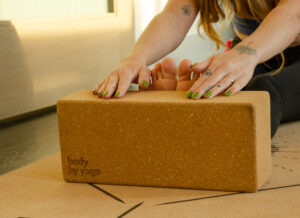
Benefits of yoga before bed
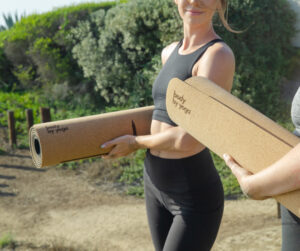
Other ways to stay involved

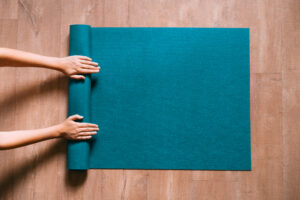
Best Mats for Yoga
Related Articles
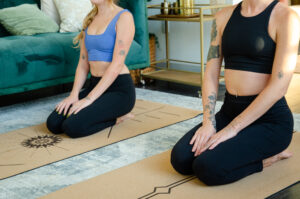
Breathing technique to improve your yoga practice
Your yoga practice can be whatever you need it to be. Yoga can be for energy and focus for your day, injury rehabilitation and prevention,

Other ways to stay involved
One of our favorite things about yoga is the community that’s behind it. We have tons of ways to be involved in our yoga community

Dynamic vs Static Stretching
Stretching is necessary in order to loosen joints, engage muscle groups, prevent injuries and help your body relax, but did you know there’s more than
